Exploring the Old Town Souk: Dubai's Cultural Heart
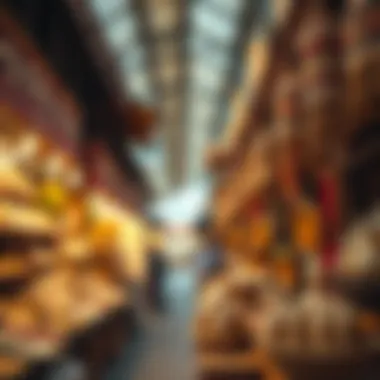
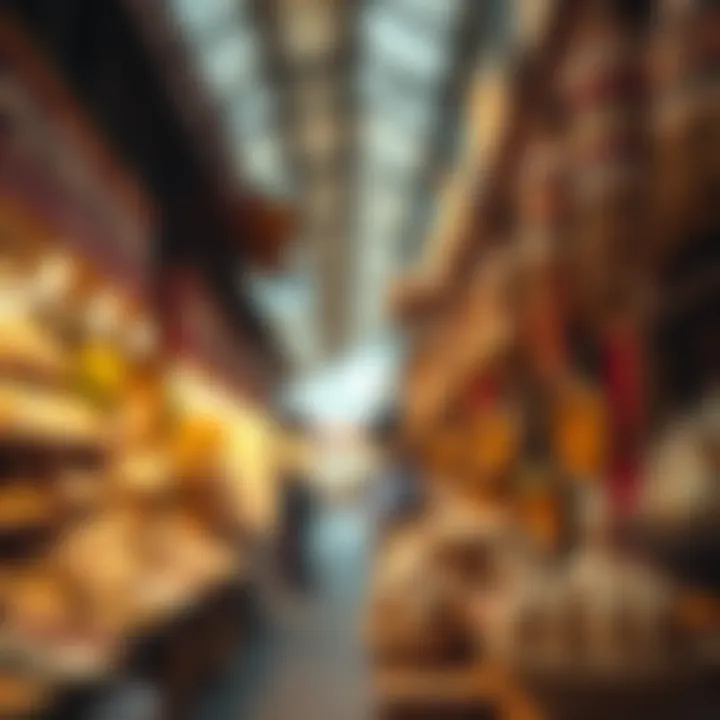
Intro
Tucked away in the heart of Dubai’s architectural marvels, the Old Town Souk stands out as a vivid tapestry of culture and commerce. This market, steeped in over a century of history, offers more than just goods; it provides visitors with a glimpse into the rich heritage of the region. The intricate pathways and charming alleyways brim with the lively sounds of bargaining shopkeepers and the aromatic wafts of spices and local delicacies. For investors and enthusiasts alike, the souk plays a pivotal role, not just as a shopping destination, but as a landmark of economic vitality and cultural heritage.
As we journey through this vibrant marketplace, we'll uncover its historical significance, distinctive architectural features, and the contemporary role it plays in Dubai's booming economy. Each corner reveals stories of ancient trades, while also hinting at the future potentials that lie within this bustling hub.
In engaging with the Old Town Souk, one not only pinpoints the pulse of Dubai’s economic framework but also appreciates the staggering impact tourism has on its longevity. This exploration aims to furnish investors and stakeholders with an enriched understanding of the symbiotic relationship between culture and commerce in one of the world's fastest-growing cities.
With this foundation laid, it’s time to delve deeper into the current state of the market, examining trends, predictions, and the symbiotic link with property investment strategies. The insights shared here will not only bolster your understanding but may well inform your ventures within Dubai's vibrant economic landscape.
Prologue to Old Town Souk
The Old Town Souk in Dubai is more than just a marketplace; it represents a vital part of the city's tapestry, weaving together threads of history, culture, and commerce. Its significance cannot be overstated for investors, realtors, architects, and developers alike, as it not only showcases traditional Emirati architecture but also serves as a bustling hub for trade and social interaction.
Nestled along the banks of the Dubai Creek, the souk is steeped in centuries of trading history. It dates back to the city's early roots when Dubai established itself as a crucial center for trading routes across the Persian Gulf. The souk is a vivid reminder of a time when barter was the lifeblood of commerce, connecting various cultures and facilitating the exchange of goods ranging from spices and textiles to handmade crafts.
Today, the Old Town Souk is a beautifully designed blend of old and new. Investors shouldn’t overlook its potential not only as a commercial space but also as a cultural landmark. As urban landscapes evolve, understanding the essence of places like the souk becomes increasingly important. It offers a unique glimpse into Dubai’s past while thriving in modern commercial activity, benefiting from both local patrons and tourists who flock to its vibrant stalls.
In short, the Old Town Souk is a microcosm of Dubai’s evolution from a modest fishing village to a global city. It stands as a testament to the city’s rich heritage while resonating with the present day. By exploring its character and offerings, stakeholders can identify emerging trends, find unique investment opportunities, and appreciate the intricate relationship between culture and commerce in today's urban environment.
As we embark on this exploration of the Old Town Souk, we will delve into its historical roots, architectural uniqueness, and economic impact—highlighting its significance in shaping the current landscape of Dubai.
"The essence of this souk lies not only in its goods but in the stories it tells and the connections it fosters between people."
Through understanding this nexus of culture and commerce, one can better grasp how such historic spaces continue to thrive amidst rapid modernization, paving the path for future developments.
Historical Context
The Old Town Souk is not just a market; it is the very heartbeat of Dubai's vibrant tapestry of culture and commerce. Understanding its historical context provides invaluable insight into the evolution of trade and social interactions within the region. By examining how the Old Town Souk came to be, one can appreciate its role as a bridge between rich traditions and modernity.
Delving into the historical aspects serves multiple purposes for investors, developers, and enthusiasts alike. It highlights the enduring legacy of Dubai as a trading hub, showcasing how ancient practices weigh into the contemporary commercial landscape. This narrative lends perspective on future developments and helps real estate stakeholders gauge the potential of the area, revolving around authenticity and charm that attracts both tourists and locals.
Origins of Trade in Dubai
The trade roots of Dubai go back centuries, with small fishing and pearling communities in the region forming the first threads of commerce. Before the discovery of oil, the local economy heavily relied on these industries, supported by the geographical advantages of the area. Located near the Persian Gulf, Dubai was uniquely positioned as a stopover for traders traversing between the East and the West. This strategic location not only facilitated a vibrant exchange of goods but also ideas and cultures.
- Merchants would gather at ports, exchanging ivory, spices, and textiles, setting the stage for what would become a bustling trade network.
- Through local markets, goods flowed into the surrounding desert communities, creating an early version of what we now see in the Old Town Souk.
The blend of diverse cultures shaped the identities of traders, leading to a melting pot of influence that persists in contemporary Dubai. Names of places still echo stories of the past, such as the historic Al Fahidi District where tales of trade waft through alleyways, unraveling the fabric of Dubai's legacy.
Development of the Old Town Souk
As trade flourished, the need for organized marketplaces became apparent. Thus, the Old Town Souk began its development, officially recognized as a marketplace that encapsulated the spirit of Dubai. Building on centuries of local trading practices, the souk evolved from makeshift stalls to a structured market space where artisans and traders could display their wares.
- Key milestones in the development of the souk include the establishment of governing bodies that regulated trade practices and taxation.
- Over time, the souk grew to accommodate a broader range of goods, consolidating into the vibrant marketplace known today.
The architectural design of the Old Town Souk also reflects these historical roots, with traditional wind towers and striking archways drawing on vernacular styles. While modern pitfalls threaten to overshadow this heritage, the commitment to preserving its authenticity remains strong.
"The Old Town Souk stands as a testament to the resilience and creativity of Emirati culture, merging the past with the rhythm of modern life."
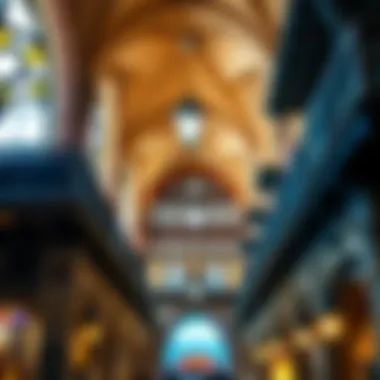
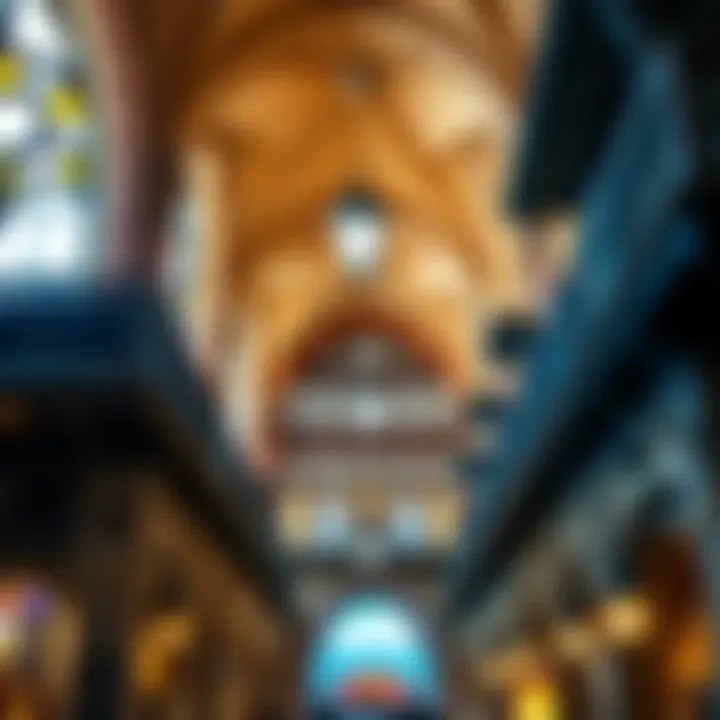
In summary, the historical context of the Old Town Souk serves not just as a backdrop for understanding its current state but as a lens through which to visualize its future. By grasping how trade emerged and how the souk developed, real estate investors and enthusiasts become better equipped to appreciate both the cultural depth and economic potential of this notable market.
Architectural Characteristics
The Old Town Souk in Dubai serves as a striking example of architecture that reflects both cultural heritage and practical functionality. This section delves into the essential elements of its architecture, providing insights into how its design plays a pivotal role in not only preserving the soul of the souk but also enhancing its appeal as a commercial hub.
Design Elements of the Souk
The design of the Old Town Souk expertly marries traditional Arabic style with modern touches. The winding pathways and open courtyards create an inviting atmosphere for visitors. The use of arches and intricate latticework not only enhances the visual beauty but also provides necessary shade from the unforgiving sun.
Visitors often remark about how the buildings seem to usher them through the market, guiding their exploration while also creating a sense of community. High ceilings, combined with large windows and airy spaces, allow for natural light to flood in, making shopping a pleasurable experience. Furthermore, one might observe how the layout encourages interaction among vendors and shoppers alike, fostering a lively marketplace vibe.
The omnipresence of traditional Islamic patterns is also noteworthy. These motifs, often seen on tiles and fabrics, tell stories that date back centuries. Every corner seems to whisper tales of the past, enriching the shopping experience. Moreover, the strategic placement of seating areas encourages momentary breaks, allowing visitors to soak in the ambiance while sipping on traditional Arabic coffee or tea.
The architectural interplay within the souk provides more than mere aesthetics; it anchors commerce in tradition while elevating the market experience.
Materials and Construction Techniques
Understanding the materials and construction techniques that define the Old Town Souk provides critical context for its architectural character. The structures primarily use stone, plaster, and wood, with local materials harmoniously integrated into the fabric of the buildings. This not only showcases the natural resources available in the region but also reflects a commitment to sustainability and local craftsmanship.
Mud brick constructions can be traced back to ancient times, and in the souk, this method speaks volumes about environmental adaptation. The thermal properties of these materials help maintain a cooler interior during the hot summer months while keeping warmth inside during cooler winter evenings. This natural air conditioning is effectivley cost-efficient and eco-friendly.
Moreover, the skilled artisans who participate in the construction process add a layer of authenticity to the buildings. Many local craftspeople utilize traditional techniques that have been passed down through generations, showcasing intricate woodwork and hand-carved details. This blend of modern and ancient practices not only supports the local economy but also preserves a way of life that emphasizes artistry over mass production.
In essence, the architectural characteristics of the Old Town Souk encapsulate the essence of Dubai, where the past meets the present, creating a vibrant space that is both functional and aesthetically pleasing.
Cultural Significance
The Old Town Souk plays an invaluable role not just in commerce, but also in fostering cultural identity among Dubai’s residents and its diverse visitors. Its significance stretches beyond a mere marketplace; this souk embodies the heart and soul of the local community. It serves as a vibrant tapestry of traditions where the threads of history, identity, and modernity intertwine.
In a fast-paced city like Dubai, where skyscrapers dominantly feature in the skyline, the essence of local culture can sometimes feel lost in translation. Yet, stepping into the souk, one can observe the authentic hustle and bustle, undisturbed by the clamor of modernization. The aromas wafting through the air—from spices to dates—ignite memories and stories of life before the skyscrapers, linking generations of Emiratis and expatriates alike.
- Community Bonding: The souk acts much like a local town square where people gather, share ideas, and build connections. This sense of community is important for preserving local customs and practices. It’s a place where artisans hawk their crafts, stories are exchanged, and future friendships blossom. The interactions formed here go beyond simple transactions; they signal a deep-rooted culture that promotes collaboration and camaraderie.
- Cultural Showcase: Within the marketplace, one finds a variety of goods steeped in local tradition. Whether it’s intricate handicrafts, traditional textiles, or local spices, each item tells a story. These artifacts aren’t merely products, but representations of a rich heritage that thrives amidst a rapidly globalizing world. Visitors experience firsthand the pride that locals take in their products, which helps to sustain traditional crafts that might otherwise fade away.
- Festivals and Celebrations: The souk also hosts various cultural events, often centered around Islamic holidays and local festivities, encouraging participation from residents and tourists alike. This active engagement in cultural celebrations offers visitors an immersive experience, enabling a deeper understanding of the Emirati way of life. It’s these moments that transform the souk into a lively hub infused with joy and togetherness.
Ultimately, the cultural significance of the Old Town Souk lies in its ability to connect people—both locals and visitors—creating a shared context for understanding and appreciating Dubai’s diverse culture. This transformation from a simple marketplace to a cultural hub has profound implications for how communities navigate the challenges of globalization while holding on to essential aspects of their heritage.
Commercial Landscape
The Commercial Landscape of the Old Town Souk offers a microcosm of Dubai's vibrant trade and social interactions. It's not merely a market; it's a lively intersection where local and international endeavors meld seamlessly. The souk serves as a crucial platform for artisans and traders to showcase their wares, fostering community connections and fueling the local economy. The implications of this commercial landscape extend beyond the immediate economic benefits, influencing tourism patterns and residential investments in the surrounding areas.
Variety of Goods on Offer
Stepping into the souk, visitors are greeted with a smorgasbord of products that reflect the rich tapestry of Dubai's culture. From handwoven textiles to intricate silver jewelry, the diversity of goods on offer paints a picture of tradition meeting modernity. Street vendors and established retailers peddle everything from fragrant spices to artisan crafts, ensuring that there's something for every taste and budget.
- Textiles: Colorful fabrics in various textures entice buyers, showcasing modern designs interwoven with traditional patterns.
- Spices: The air is thick with the aroma of exotic spices, ranging from saffron to sumac, nestled in vibrantly colored bins.
- Jewelry: Handmade silver rings and necklaces shine under the glow of traditional lanterns, drawing in admirers.
- Artwork: Local artists display pieces that capture the spirit of Dubai, merging contemporary techniques with traditional motifs.
The selection not only highlights the richness of local craftsmanship but also serves as a magnet for tourists and investors alike, keen to take a piece of Dubai's bustling life back home.
Pricing Trends and Buying Behavior
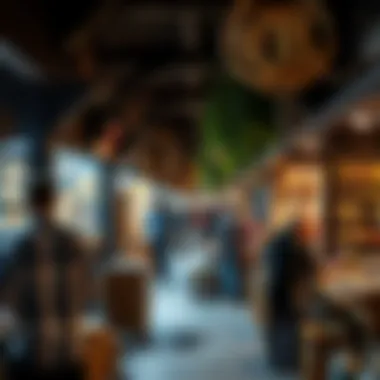
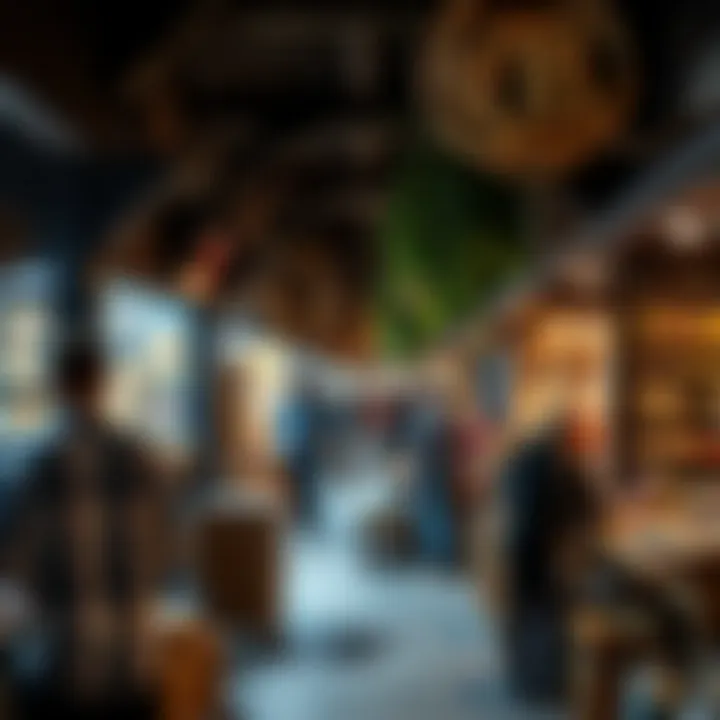
Understanding pricing trends and buying behavior in the Old Town Souk provides critical insights for potential investors and entrepreneurs. Local dynamics often dictate prices, influenced by various factors such as craftsmanship quality, material type, and seasonal demand.
Shoppers here are typically looking for authenticity and are often willing to pay a premium for unique, locally-made items. Negotiation is commonplace; haggling is part of the experience, offering a more personalized and engaging interaction than in most retail settings. Visitors can expect:
- Price Variation: Goods can vary significantly in price, with handmade items often carrying a higher price tag due to their artistry.
- Consumer Behavior: Shoppers often seek to understand the story behind each product, making them more likely to invest in items that resonate with their values.
- Seasonal Trends: Prices may fluctuate during festivals or special events, reflecting increased demand—and can be a decisive factor for vendors.
By navigating these aspects, both shoppers and investors can glean valuable knowledge about the souk’s economic landscape, ensuring a well-informed approach to transactions.
"In the Old Town Souk, every item tells a story—some are worth their weight in gold, but others offer untold value in memories and connections."
Visitor Experience
The charm of the Old Town Souk in Dubai resonates deeply with visitors, attracting a diverse crowd, from seasoned travelers seeking a slice of authentic culture to expatriates wanting to immerse themselves in the marketplace's vibrancy. An enriching visitor experience is crucial as it shapes perceptions of culture, history, and commerce, all intertwined in this bustling hub. Moreover, it can directly influence the local economy as satisfied tourists often spread the word, drawing even more foot traffic to the area.
Navigating the Souk
Traversing through the Old Town Souk is nothing short of an adventure. The labyrinthine pathways are adorned with traditional architecture, allowing for a delightful exploration. Visitors should take note of the following tips when navigating the souk:
- Plan Ahead: Researching the layout and key attractions can help in maximizing one’s experience. Knowing where to find specific shops—like those selling spices or textiles—enhances the journey.
- Engage with Locals: The shopkeepers can offer insights and stories about the souk, often making interactions memorable. Their personal anecdotes contribute depth to the shopping experience.
- Be Open to Wander: Sometimes, the most potent discoveries emerge unexpectedly. Strolling through narrow alleys can lead to unique finds and hidden gems that aren’t on any tourist map.
The atmosphere is alive with sounds and colors, presenting a sensory feast.
Culinary Delights and Dining Options
Food plays a significant role in the experience of the Old Town Souk. From tantalizing street food stalls to inviting cafés, the culinary landscape is as diverse as it is delicious.
Visitors are often recommended to try:
- Shawarma: These wraps are a staple in Middle Eastern cuisine, combining perfectly spiced meats with fresh veggies.
- Knafeh: A sweet, cheesy dessert that is an absolute must for those with a sweet tooth.
- Arabic Coffee: Symbolic of hospitality, this brew is a delightful way to immerse oneself into Emirati culture.
Additionally, dining options range from casual eateries to more upscale restaurants, catering to all types of budgets and preferences. For those who prefer local flavors, small dining establishments serve homestyle dishes—reflecting the rich culinary traditions of the region.
With so many flavors to offer, the Old Town Souk stands not only as a cultural marketplace but as a culinary destination. The experience of savoring food right within this lively marketplace makes the visit a multisensory delight.
"In the souk, every bite tells a story, and each interaction brings a smile."
This combination of navigating the souk and indulging in its culinary offerings creates a layered experience that resonates well beyond a simple visit, fostering connections to both the land and its people.
Impact of Tourism
The Old Town Souk stands as a cornerstone of Dubai’s tourism landscape. Tourism here isn't just a fleeting interest; it serves as a catalyst for economic growth, cultural exchange, and community development. As tourists flock to the souk, they engage with the vibrant local culture and partake in age-old trading practices, which enrich their experience and the city’s fabric.
Tourism in this area ignites a myriad of benefits, many of which ripple outwards to reinforce local traditions and stimulate the commercial sector. As visitors browse the colorful stalls, they contribute to the lively atmosphere by purchasing everything from handcrafted souvenirs to exotic spices. This influx not only elevates the market's vibrancy but also sustains local artisans and traders, many of whom rely on tourists to maintain their livelihoods.
Tourism Trends and Statistics
Recent data reveals fascinating insights into visitor dynamics at the Old Town Souk. With Dubai ranking among the top global travel destinations, the souk is a must-visit spot for travelers. Statistics indicate that approximately
- 15 million tourists visit Dubai annually.
- The Old Town Souk draws nearly 1.5 million of those visitors each year.
- On average, each tourist spends about $70 during their visit to the souk.
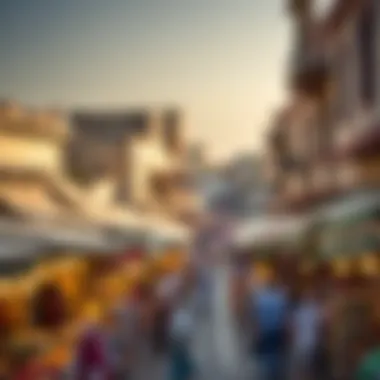

This foot traffic showcases the significant role of tourism in revitalizing the area. Moreover, the demographic of visitors includes a diverse mix of expatriates, adventure-seekers, families, and cultural enthusiasts. Each group brings unique purchasing habits and preferences, thereby diversifying the offerings and driving seasonal business trends.
Effects on Local Businesses
The impact of tourism on local businesses within and surrounding the Old Town Souk cannot be overstated. Increased foot traffic translates into higher sales, which supports not only individual vendors but also enhances the surrounding ecosystem of shops and services. When tourists purchase locally made goods, they help preserve traditional crafts and support artisans—ensuring that the soul of the souk remains intact.
However, this boom in tourism does come with challenges. Some local businesses may find it hard to keep pace with the changing demands of an evolving market—especially when competing with larger retailers who can sell at lower prices.
At the same time, rising demand for diverse products has encouraged many local vendors to adapt, leading to more innovative offerings.
In summary:
- Tourism significantly boosts overall sales for local vendors.
- It promotes cultural preservation and the crafting of traditional goods.
- A challenge exists for smaller shops to compete with mass-produced items.
As the souk continues to evolve, it's crucial for local businesses to maintain their unique identities while keeping in mind the ever-changing landscape of tourism. The future seems to promise a melding of old and new, where traditional practices flourish against the backdrop of a thriving tourism sector.
Future Developments and Trends
The concept of future developments and trends plays a pivotal role in understanding how the Old Town Souk can adapt and thrive amidst the gonig urban evolution of Dubai. Investors, architects, and real estate developers must keep a finger on the pulse of these changes as they can signal lucrative opportunities or potential challenges. Knowing what’s on the horizon allows stakeholders to align their strategies and enhance their prospects in a competitive market.
Urban Development Projects
In the heart of Dubai, various urban development projects are reshaping the landscape around the Old Town Souk. The Dubai government has been investing heavily in infrastructure to connect traditional markets with modern amenities. For instance, the expansion of the public transport system, like the Dubai Metro, aims to make the souk more accessible to global tourists and locals alike.
Furthermore, renovation projects are underway to restore historic buildings while incorporating contemporary designs. These projects not only enhance the aesthetic appeal but also serve to attract high-end retail tenants. The objective seems clear: to meld the old with the new, creating a seamless experience for visitors.
- Enhancements to Connectivity: Improved transport links, such as new metro stations and better road access, aim to ease the flow of foot traffic.
- Mixed-use Developments: New projects often feature a blend of commercial and residential spaces, ensuring a vibrant atmosphere at all hours.
- Art Integration: Initiatives to include art installations and cultural exhibitions offer a fresh perspective on Dubai's heritage while enriching the consumer experience.
These developments are more than just construction projects; they reflect a commitment to retaining the cultural essence of the souk while making it appealing to a modern audience.
Sustainability Measures in Practice
Sustainability is also at the forefront of future developments within the Old Town Souk. With the world increasingly focusing on eco-friendly practices, Dubai is no exception. Local authorities have begun implementing sustainability measures aimed at reducing the carbon footprint of new constructions and promoting green living.
Here are some notable practices:
- Green Building Standards: New buildings must adhere to regulations that prioritize energy-efficient designs, natural lighting, and water conservation systems.
- Waste Management Programs: Initiatives to improve waste management involve recycling and composting programs that engage both businesses and customers.
- Sustainable Transportation Options: The introduction of electric buses and enhanced cycling paths encourages visitors to explore the souk and surrounding area without relying on cars.
To build a vibrant future, we must ensure that our past is preserved, not at the expense of our environment.
The End
The Old Town Souk stands as a beacon of Dubai's rich tapestry, intertwining culture and commerce in a manner that speaks volumes about the city’s heritage. In examining the souk, one gains insight into how history shapes contemporary lifestyle and business in this fast-paced metropolis. The synergy between the traditional and the modern within the souk's bustling pathways showcases the importance of preserving cultural identities in the face of rapid urban development.
Investors and developers may find the souk particularly compelling due to its ability to attract tourists and locals alike. This influx not only fuels the local economy but also enhances the property values in the surrounding areas. The cultural events held in the souk create unique opportunities for businesses, encouraging a vibrant marketplace and fostering community ties.
Key Elements to Consider:
- Cultural Heritage: The souk serves as a reminder of Dubai’s past, a narrative that adds depth to its modern facade.
- Economic Impact: It generates significant revenue through tourism, which can be appealing for investment.
- Community Engagement: Events and collaborations within the souk help strengthen connections, vital for local and expatriate communities.
Understanding the various dimensions of the Old Town Souk is essential for real estate investors and stakeholders looking to grasp the implications of culture in commerce.
As we observe the trends of urbanization in Dubai, it's clear that spaces like the Old Town Souk will remain pivotal in maintaining the essence of what makes this city so unique. Thus, appreciating this nexus between culture and commerce not only enriches the visitor experience but also assures sustainable investments for the future.
A vibrant marketplace does not merely sell goods but cultivates connections that enrich community life.
For further reading, consider exploring resources like Britannica for historical insights or Wikipedia for comprehensive information on the city’s evolution.















